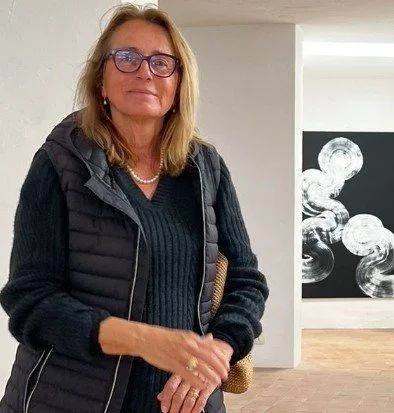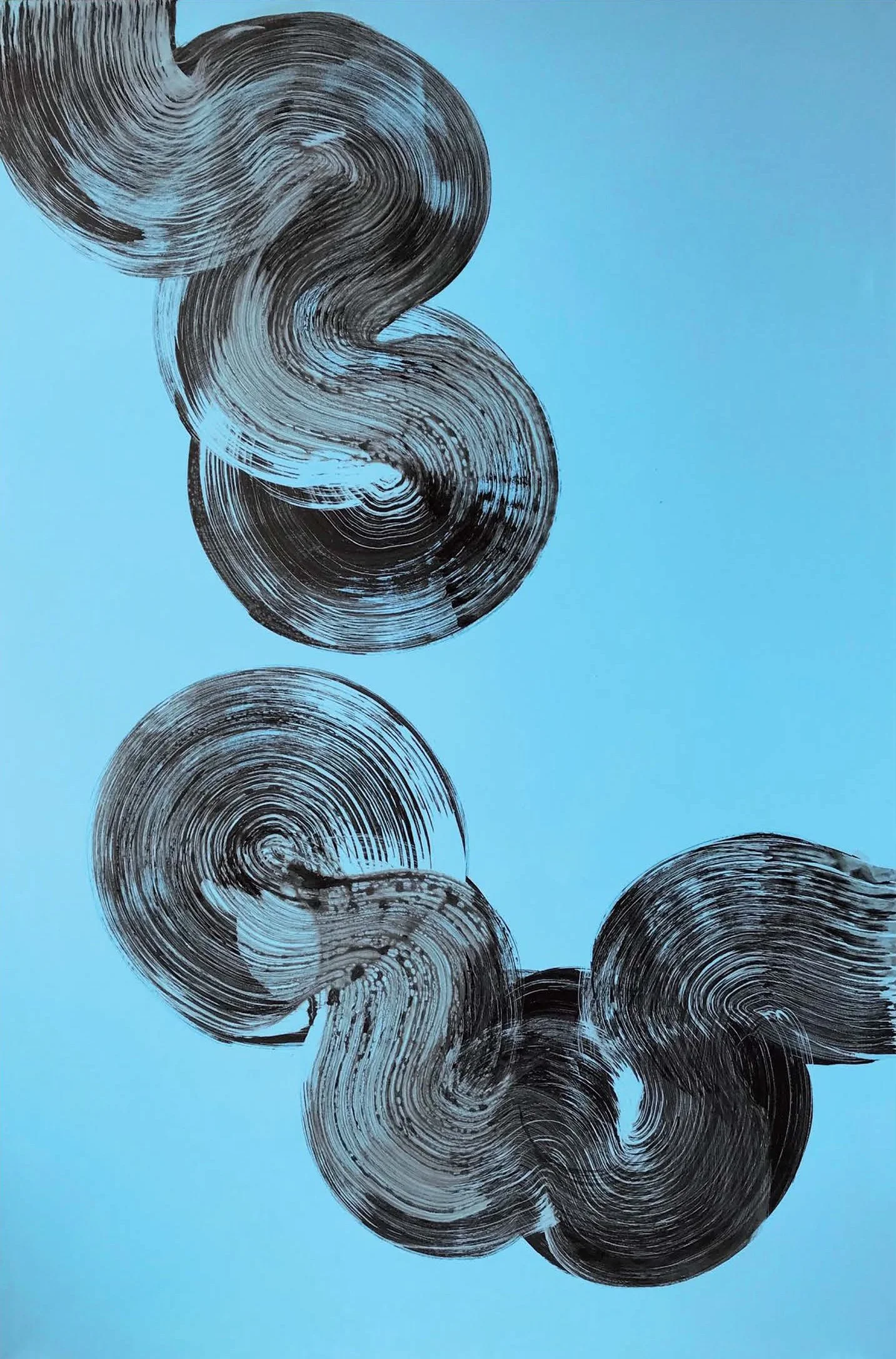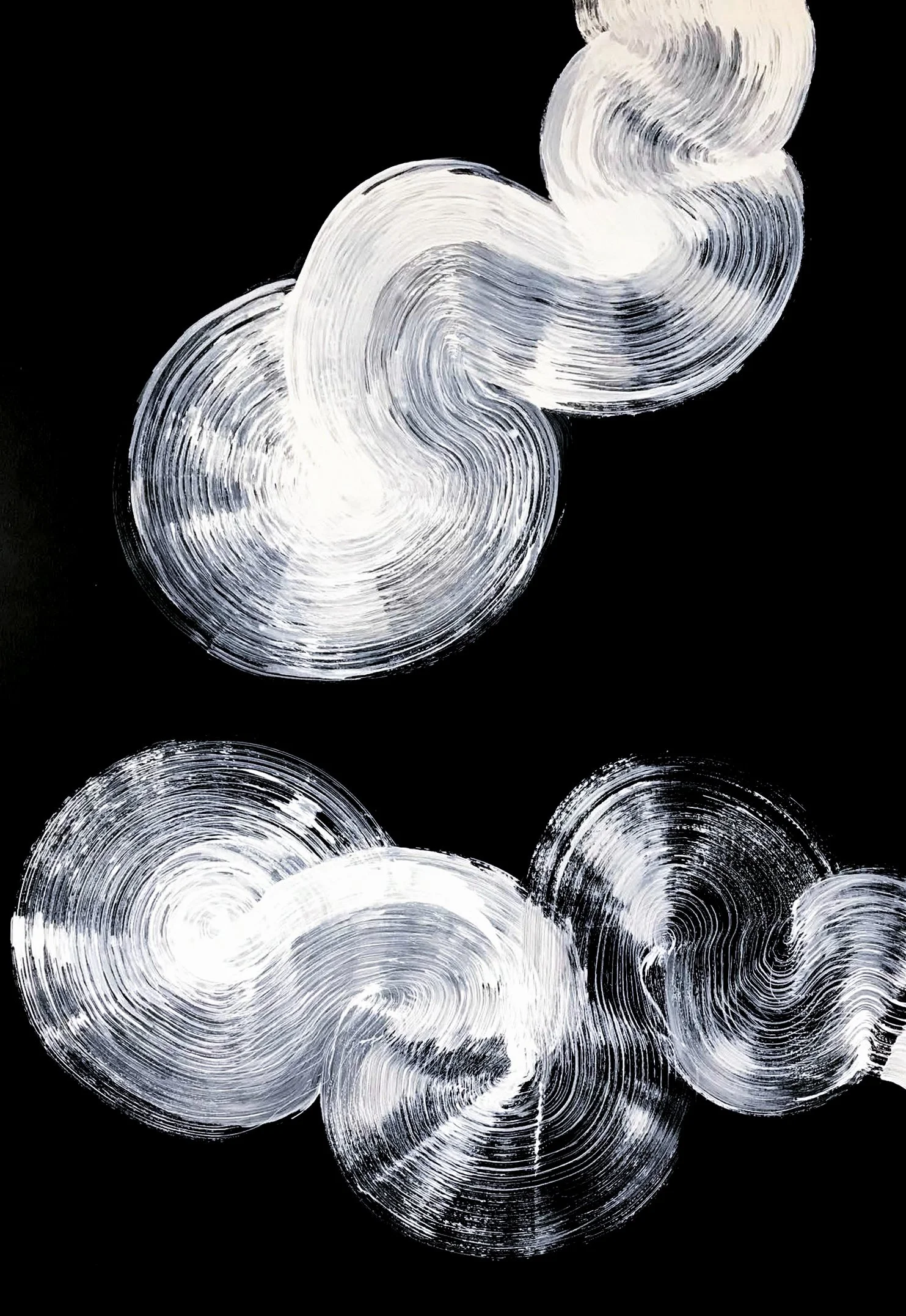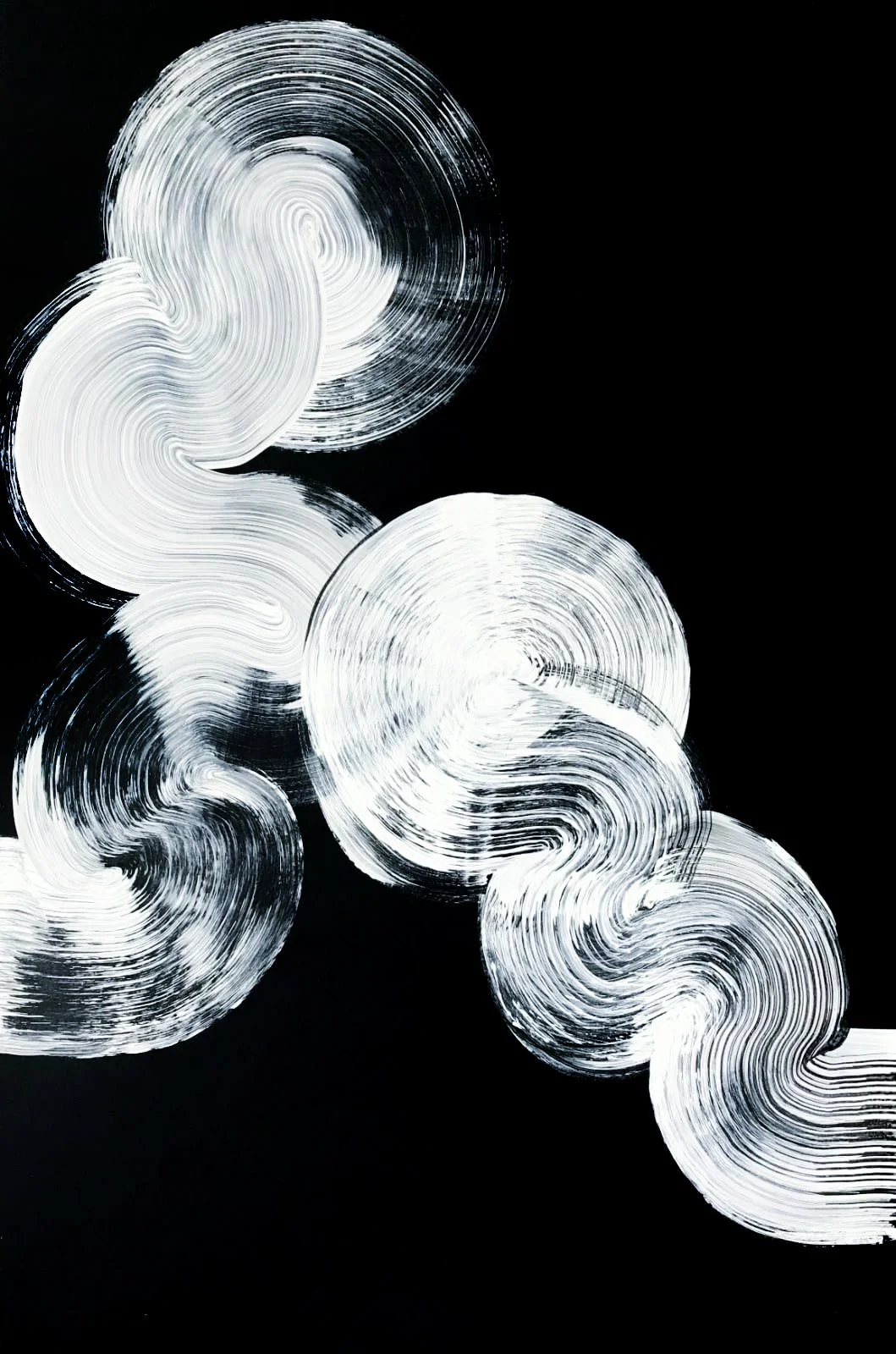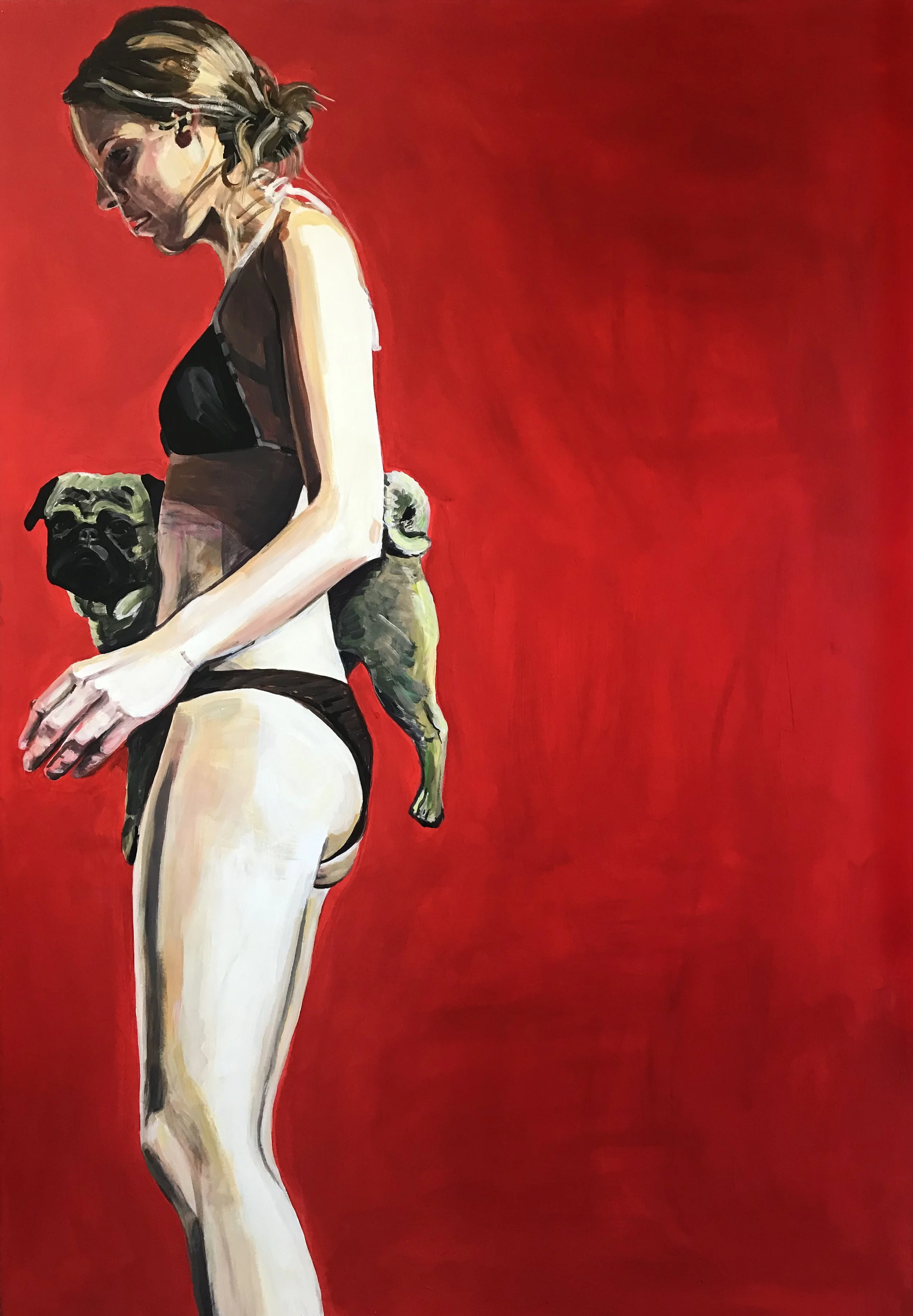Ruźa Spak
Ruźa Spak
Acrylic on canvas and paper
With energy and elegance, wide swaths of paint wind their way over a monochrome ground. They meander, overlap and nestle into one another. In a dance, the coursing paint seizes the seemingly unbounded pictorial space.
With clear, powerful strokes and using only a few tools – brush and acrylic paint on canvas or paper – the painter Ruźa Spak creates unmistakable pictorial worlds. Since 2019, she has been working on a series of abstract works which is characterized by dynamic bands of paint on a contrasting ground: color combinations of red and white, purple and black, black and green and, as can be seen here at the Malte Uekermann gallery exhibition, dialogs of black and white or else black and azure with tones of gray.
The artist brings life to organically curving formations, using a brushstroke that can be anywhere from transparent to pasty. It is striking how the swaths of paint circle around themselves where they begin and where they end. From a single pirouette, they gather strength and take off. These centers of force create a tension on the canvas, turning the bands of paint into headstrong characters, into independent actors in the image. They generate a sense of movement, though the composition is simultaneously calm and steady. This effect is possible because the image is pared down to the essential. The blue series in particular achieves a fascinating sense of lightness with its of two, three, or more interrelated black and gray tracks set against a monochrome sky-blue background.
These works are more captivating still because of the spontaneity with which they were created. Ruźa Spak does not attempt to mold certain shapes, but instead intuitively devotes herself to the space of possibilities offered by her brushstroke and the dialog that arises from it. To complete her work, she lays the stretched canvas down on the floor of her studio. First, she creates an even ground, choosing a single paint color.
Before the first paint layer is dry, she allows herself to be guided by the moment in a second step: standing bent over, she faces the canvas in a manner than demands much of her physically, and paints from the center of her body. In this way, the second paint application, which is pasty and in part glazing, comes to reflect her own movements. The brush moves at times faster, at times slower over the canvas, turns or runs over the edge.
The painting movement and the intuitively generated composition are not only circumscribed by the size of the canvas but are also influenced by the artist’s body. The radius of her arms, the mobility of her wrists and the strength of her legs and back all help determine the space of creative possibility. Brought forth in this interplay of the material with the artist’s body and experienced eye are those typical characteristics that give the work an inimitable life of its own.
Close observation reveals further facets of this singular inner life: in the group of black and whitenworks on paper, for example, the white swaths of paint stand out clearly from the black background. The viewer is met with a twinkle of reflections. Perhaps they are intentional; in any case they are testimony to the painting process because wherever the brush is set down anew, where it slows down, or where tracks of paint overlap, the result is a heavier paint application. These contrasts evoke high points and depths and add to the physicality of the paint.
In comparison with artists such as K.O. Götz and Hans Hartung, who similarly take a pared-down approach to their work and create pictorial worlds that are likewise dynamic and abstract, Ruźa Spak’s gesture is not pointed and wild. Her working process is more in harmony with her painting tools and she carries out her movements in a softer and more controlled manner. She exposes not the materials but herself to physical strain, and she generates pictorial tension through the interaction of paint tracks, centers of force, and contrasts. For this, the gestures of her painting need not be sweeping and impulsive.
With her current work series, Ruźa Spak moves twentieth-century American and French abstract painting, which is so close to her, into the present day – with surprising results.
Julia Fernow (art critic)
I have two painting of Ruźa Spak in two different houses: they are triptychs, three sequences of images that run and catch each other. Radiating and shining, are the first adjectives that comes to my mind when describing them. Undoubtely the lighten my day and are full of light and of life.
There is color, there is substance, there is Mediterranean light, there is the emergence of many common expressive affinities: lightness and transparence. Images that stand still for a moment in the course of time. Then, in her following works, they started to arise on the surface of fragments, without the weight of history: icons creased by the past that challenge the law of gravity.
Renzo Piano
Ruźa Spak, born in Poland, studied painting at the Kunstakademie Hamburg and the Akademie der Künste in Berlin. She also received a DAAD scholarship for Rome.
She lives and works in Berlin.
Portraits (selection)
Former German Chancellor, Angela Merkel, for Cicero Magazine. 2012
Prime Minister of Poland, Donald Tusk, for the European Prize for Political Culture. 2016
Selected solo exhibitions
2021 Malte Uekermann Kunsthandel, Berlin, Germany
2008 Schultz Gallery, Seoul, Korea
2008 ArtFair21, Galerie Barbara von Stechow, Cologne, Germany
2006 Galleria, Rome, Italy
2005 Residence of the German Ambassador, London, UK
2002 Emory University, Claus M. Halle Institute, Atlanta, USA
2001 Goethe Institut, Washington D.C., USA
2000 Kunstverein Schering, Berlin, Germany
1998 Texas Union Art Gallery, Austin, USA
1997 Fitzpatrick Troyer Lassman Gallery, Washington D.C., USA
Selected group exhibitions
2025 Espacio Micus, Ibiza, Spain
2022 Fred Schnider Gallery of Art, Arlington, USA
2021 Pinacoteca Comunale di Gaeta, Gaeta, Italy
Women & Flint in Arts, Schaffhausen, Switzerland
2018 Contemporary Art Center and Pacai Palace, Vilnius, Lithuania
2015 Octavia Gallery, New Orleans, USA
2012 Musée des Tapisseries, Aix-en-Provence, France
2010 Beijing, China (Invitation | Homepage)
2009 Kunsthalle Dresden, Dresden, Germany
DEPO, Istanbul, Turkey
2008 Art Fair 21, Galerie Barbara von Stechow, Cologne, Germany
Michael Schultz Galerie, Seoul, Korea
Galerie Barbara von Stechow, Frankfurt am Main, Germany
2007 Kunstraum Klosterkirche, Traunstein, Germany
2006 Wichita Falls Art Museum, Wichita Falls, USA
2005 Museum of Modern Art, Pretoria, South Africa
Woman Museum in Arlington National Cemetery, Virginia, USA
2003 The Millenium Arts Center, Washington D.C., USA
www.ruzaspak.com
Instagram @ruzaspak



